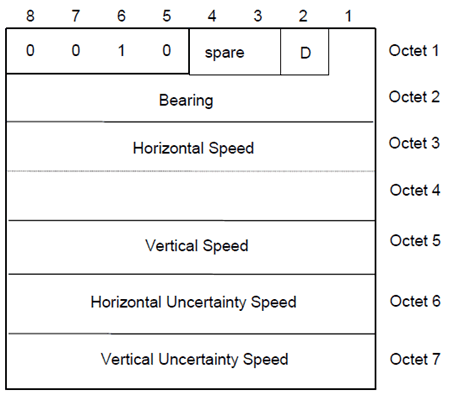Content for TS 23.032 Word version: 18.3.0
8 Description of Velocity
8.1 Horizontal Velocity
8.2 Horizontal and Vertical Velocity
8.3 Horizontal Velocity with Uncertainty
8.4 Horizontal and Vertical Velocity with Uncertainty
8.4a Relative Velocity with Uncertainty
8.5 Coding Principles
8.6 Coding of Velocity Type
8.7 Coding of Horizontal Speed
8.8 Coding of Bearing
8.9 Coding of Vertical Speed
8.10 Coding of Vertical Speed Direction
8.11 Coding of Uncertainty Speed
8.12 Coding of Horizontal Velocity
8.13 Coding of Horizontal with Vertical Velocity
8.14 Coding of Horizontal Velocity with Uncertainty
8.15 Coding of Horizontal with Vertical Velocity and Uncertainty
8 Description of Velocity p. 31
A description of velocity is applicable to any target entity on or close to the surface of the WGS84 ellipsoid.
8.1 Horizontal Velocity p. 31
Horizontal velocity is characterised by the horizontal speed and bearing. The horizontal speed gives the magnitude of the horizontal component of the velocity of a target entity. The bearing provides the direction of the horizontal component of velocity taken clockwise from North.
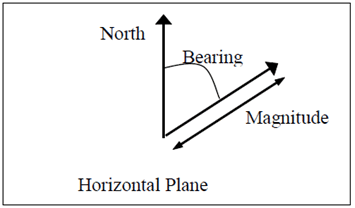
8.2 Horizontal and Vertical Velocity p. 31
Horizontal and vertical velocity is characterised by horizontal speed, bearing, vertical speed and direction. The horizontal speed and bearing characterise the horizontal component of velocity. The vertical speed and direction provides the component of velocity of a target entity in a vertical direction.
8.3 Horizontal Velocity with Uncertainty p. 31
Horizontal velocity with uncertainty is characterised by a horizontal speed and bearing, giving a horizontal velocity vector V and an uncertainty speed s. It describes the set of velocity vectors v related to the given velocity V as follows:
|v – V | ≤ s
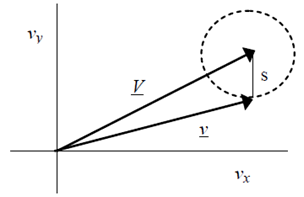
8.4 Horizontal and Vertical Velocity with Uncertainty p. 31
Horizontal and vertical velocity with uncertainty is characterised by a horizontal speed and bearing, giving a horizontal velocity vector Vx,y , a vertical speed and direction giving a vertical velocity component Vz ,and uncertainty speeds s1 and s2. It describes the set of velocity vectors v with horizontal and vertical components vx,y and vz that are related to the given velocity components Vx,y and Vz as follows:
|vx,y – Vx,y, | ≤ s1
|vz - Vz| ≤ s2
8.4a Relative Velocity with Uncertainty p. 32
The relative velocity with uncertainty of a device B relative to a device A is characterised by a radial velocity component (measured in meters / second) and a perpendicular transverse velocity component (measured in degrees / second). The radial velocity component is characterized by a rate of change of a range between the device A and device B. The transverse velocity component is characterized by a rate of change of a direction to the device B from the device A, where the change rate of the direction includes the change rate of an angle of azimuth (measured in degrees / second) and change rate of an angle of elevation (measured in degrees / second). The angle of azimuth is measured clockwise from North in a horizontal plane through the device A and the angle of elevation measured upwards or downwards in a vertical plane through the devices A and B from a horizontal plane through the device A. The rates of change of the range and the angles of azimuth and elevation can be each independently included or excluded in the relative velocity and each has an uncertainty and a confidence,
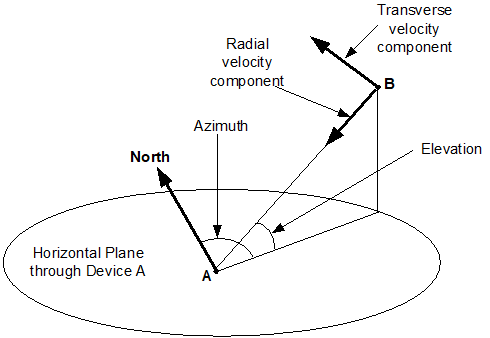
8.5 Coding Principles p. 32
Velocity is encoded as shown in Figure 13. The velocity type in bits 8-5 of octet 1 defines the type of velocity information in succeeding bits.
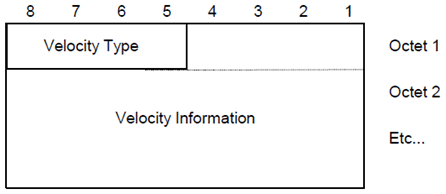
8.6 Coding of Velocity Type p. 33
Table 3 shows the coding of the velocity type.
| Bits
4 3 2 1 |
|
|---|---|
| 0 0 0 0 | Horizontal Velocity |
| 0 0 0 1 | Horizontal with Vertical Velocity |
| 0 0 1 0 | Horizontal Velocity with Uncertainty |
| 0 0 1 1 | Horizontal with Vertical Velocity and Uncertainty |
| other values | reserved for future use |
8.7 Coding of Horizontal Speed p. 33
Horizontal speed is encoded in increments of 1 kilometre per hour using a 16 bit binary coded number N. The relation between the number N and the horizontal speed h (in kilometres per hour) it encodes is described by the following equations:
N ≤ h < N + 0.5
(N = 0)
N – 0.5 ≤ h < N + 0.5
(0 < N < 216-1)
N – 0.5 ≤ h
(N = 216-1)
8.8 Coding of Bearing p. 33
Bearing is encoded in increments of 1 degree measured clockwise from North using a 9 bit binary coded number N. The relation between the number N and the bearing b (in degrees) it encodes is described by the following equation:
N ≤ b < N+1
except for 360 ≤ N < 511 which are not used.
8.9 Coding of Vertical Speed p. 33
Vertical speed is encoded in increments of 1 kilometre per hour using 8 bits giving a number N between 0 and 28-1. The relation between the number N and the vertical speed v (in kilometres per hour) it encodes is described by the following equations:
N ≤ v < N + 0.5
(N = 0)
N – 0.5 ≤ v < N + 0.5
(0 < N < 28-1)
N – 0.5 ≤ v
(N = 28-1)
8.10 Coding of Vertical Speed Direction p. 33
Vertical speed direction is encoded using 1 bit: a bit value of 0 indicates upward speed; a bit value of 1 indicates downward speed.
8.11 Coding of Uncertainty Speed p. 34
Uncertainty speed is encoded in increments of 1 kilometre per hour using an 8 bit binary coded number N. The value of N gives the uncertainty speed except for N=255 which indicates that the uncertainty is not specified.
8.12 Coding of Horizontal Velocity p. 34
The coding of horizontal velocity is described in Figure 14.
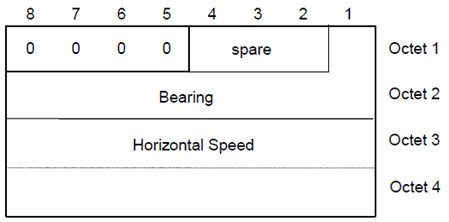
Bearing
Bit 1 of octet 1 is the high order bit; bit 1 of octet 2 is the low order bit
Horizontal Speed
Bit 1 of octet 4 is the low order bit
8.13 Coding of Horizontal with Vertical Velocity p. 34
The coding of horizontal with vertical velocity is described in Figure 15.
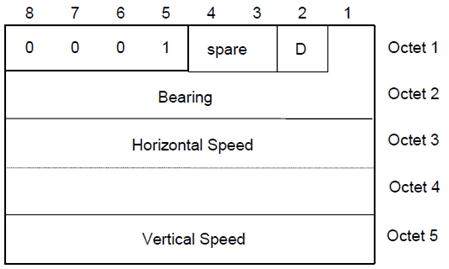
D: Direction of Vertical Speed
Bit value 0
Upward
Bit value 1
Downward
8.14 Coding of Horizontal Velocity with Uncertainty p. 35
The coding of horizontal velocity with uncertainty is described in Figure 16.
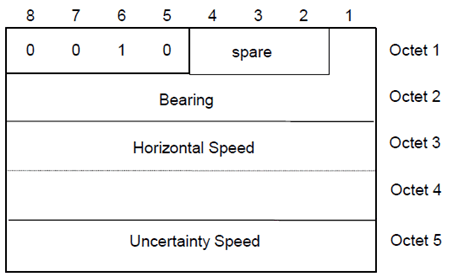
8.15 Coding of Horizontal with Vertical Velocity and Uncertainty p. 35
The coding of horizontal with vertical velocity and uncertainty is described in Figure 17.
